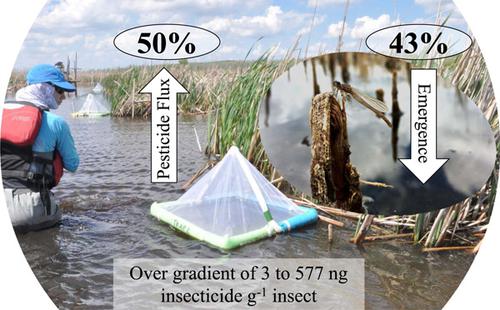当前位置:
X-MOL 学术
›
Environ. Toxicol. Chem.
›
论文详情
Our official English website, www.x-mol.net, welcomes your feedback! (Note: you will need to create a separate account there.)
Cross-Ecosystem Fluxes of Pesticides from Prairie Wetlands Mediated by Aquatic Insect Emergence: Implications for Terrestrial Insectivores
Environmental Toxicology and Chemistry ( IF 4.1 ) Pub Date : 2021-05-12 , DOI: 10.1002/etc.5111 Johanna M Kraus 1 , Kathryn M Kuivila 2 , Michelle L Hladik 3 , Neil Shook 4 , David M Mushet 5 , Kelen Dowdy 6 , Rachel Harrington 6
Environmental Toxicology and Chemistry ( IF 4.1 ) Pub Date : 2021-05-12 , DOI: 10.1002/etc.5111 Johanna M Kraus 1 , Kathryn M Kuivila 2 , Michelle L Hladik 3 , Neil Shook 4 , David M Mushet 5 , Kelen Dowdy 6 , Rachel Harrington 6
Affiliation

|
Contaminants alter the quantity and quality of insect prey available to terrestrial insectivores. In agricultural regions, the quantity of aquatic insects emerging from freshwaters can be impacted by insecticides originating from surrounding croplands. We hypothesized that, in such regions, adult aquatic insects could also act as vectors of pesticide transfer to terrestrial food webs. To estimate insect-mediated pesticide flux from wetlands embedded in an important agricultural landscape, semipermanetly and temporarily ponded wetlands were surveyed in cropland and grassland landscapes across a natural salinity gradient in the Prairie Pothole Region of North Dakota (USA) during the bird breeding season in 2015 and 2016 (n = 14 and 15 wetlands, respectively). Current-use pesticides, including the herbicide atrazine and the insecticides bifenthrin and imidacloprid, were detected in newly emerged insects. Pesticide detections were similar in insects emerging from agricultural and grassland wetlands. Biomass of emerging aquatic insects decreased 43%, and insect-mediated pesticide flux increased 50% along the observed gradient in concentrations of insecticides in emerging aquatic insects (from 3 to 577 ng total insecticide g–1 insect). Overall, adult aquatic insects were estimated to transfer between 2 and 180 µg total pesticide wetland–1 d–1 to the terrestrial ecosystem. In one of the 2 study years, biomass of emerging adult aquatic insects was also 73% lower from agricultural than grassland wetlands and was dependent on salinity. Our results suggest that accumulated insecticides reduce the availability of adult aquatic insect prey for insectivores and potentially increase insectivore exposure to insect-borne pesticides. Adult aquatic insects retain pesticides across metamorphosis and may expose insectivores living near both agricultural and grassland wetlands to dietary sources of toxic chemicals. Environ Toxicol Chem 2021;40:2282–2296. Published 2021. This article is a U.S. Government work and is in the public domain in the USA.
中文翻译:

水生昆虫出现介导的草原湿地农药的跨生态系统通量:对陆生食虫动物的启示
污染物会改变陆生食虫动物可利用的昆虫猎物的数量和质量。在农业地区,来自淡水的水生昆虫数量可能会受到来自周围农田的杀虫剂的影响。我们假设,在这些地区,成年水生昆虫也可以作为农药转移到陆地食物网的载体。为了估计嵌入重要农业景观的湿地中昆虫介导的农药通量,在鸟类繁殖季节期间,对美国北达科他州草原坑洼地区自然盐度梯度的农田和草地景观进行了半永久和临时池塘湿地调查。 2015 年和 2016 年(n = 14 和 15 个湿地,分别)。在新出现的昆虫中检测到当前使用的杀虫剂,包括除草剂阿特拉津和杀虫剂联苯菊酯和吡虫啉。来自农业和草原湿地的昆虫的农药检测相似。新兴水生昆虫的生物量减少了 43%,而昆虫介导的农药通量沿观察到的新兴水生昆虫杀虫剂浓度梯度增加了 50%(从 3 到 577 ng 总杀虫剂 g –1昆虫)。总体而言,估计成年水生昆虫在湿地中转移 2 至 180 µg 农药总量–1 d –1到陆地生态系统。在 2 个研究年的其中一个中,新兴成年水生昆虫的生物量也比草原湿地低 73%,并且依赖于盐度。我们的研究结果表明,累积的杀虫剂减少了食虫动物成年水生昆虫猎物的可用性,并可能增加食虫动物对昆虫传播杀虫剂的暴露。成年水生昆虫在变态过程中保留杀虫剂,并可能使生活在农业和草原湿地附近的食虫动物暴露于有毒化学物质的饮食来源。环境毒物化学2021;40:2282–2296。2021 年发布。本文是美国政府的作品,在美国属于公共领域。
更新日期:2021-05-12
中文翻译:

水生昆虫出现介导的草原湿地农药的跨生态系统通量:对陆生食虫动物的启示
污染物会改变陆生食虫动物可利用的昆虫猎物的数量和质量。在农业地区,来自淡水的水生昆虫数量可能会受到来自周围农田的杀虫剂的影响。我们假设,在这些地区,成年水生昆虫也可以作为农药转移到陆地食物网的载体。为了估计嵌入重要农业景观的湿地中昆虫介导的农药通量,在鸟类繁殖季节期间,对美国北达科他州草原坑洼地区自然盐度梯度的农田和草地景观进行了半永久和临时池塘湿地调查。 2015 年和 2016 年(n = 14 和 15 个湿地,分别)。在新出现的昆虫中检测到当前使用的杀虫剂,包括除草剂阿特拉津和杀虫剂联苯菊酯和吡虫啉。来自农业和草原湿地的昆虫的农药检测相似。新兴水生昆虫的生物量减少了 43%,而昆虫介导的农药通量沿观察到的新兴水生昆虫杀虫剂浓度梯度增加了 50%(从 3 到 577 ng 总杀虫剂 g –1昆虫)。总体而言,估计成年水生昆虫在湿地中转移 2 至 180 µg 农药总量–1 d –1到陆地生态系统。在 2 个研究年的其中一个中,新兴成年水生昆虫的生物量也比草原湿地低 73%,并且依赖于盐度。我们的研究结果表明,累积的杀虫剂减少了食虫动物成年水生昆虫猎物的可用性,并可能增加食虫动物对昆虫传播杀虫剂的暴露。成年水生昆虫在变态过程中保留杀虫剂,并可能使生活在农业和草原湿地附近的食虫动物暴露于有毒化学物质的饮食来源。环境毒物化学2021;40:2282–2296。2021 年发布。本文是美国政府的作品,在美国属于公共领域。

























 京公网安备 11010802027423号
京公网安备 11010802027423号